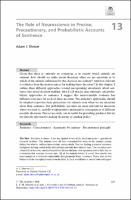Chapter 13 The Role of Neuroscience in Precise, Precautionary, and Probabilistic Accounts of Sentience
| dc.date.accessioned | 2021-03-09T09:53:52Z | |
| dc.date.available | 2021-03-09T09:53:52Z | |
| dc.date.issued | 2020 | |
| dc.identifier.uri | https://library.oapen.org/handle/20.500.12657/47111 | |
| dc.description.abstract | Given that there is currently no consensus as to exactly which animals are sentient, how should we make moral decisions when we are uncertain as to which of the animals influenced by that decision are sentient? And how relevant is evidence from the neurosciences for making these decisions? In this chapter, I outline three different approaches toward incorporating uncertainty about sentience into moral decision-making: what I call precise, precautionary, and probabilistic approaches to sentience. I suggest that neuroscientific evidence has different relevance for each of these accounts. Precautionary approaches should be adopted to provide basic protections for animals even when we are uncertain about their sentience, but probabilistic accounts are more relevant for decisions where we need to carefully weigh positive and negative consequences of different possible decisions. Precise accounts can be useful for providing guidance but are not directly relevant for making decisions or guiding policy. | en_US |
| dc.language | English | en_US |
| dc.subject.classification | thema EDItEUR::P Mathematics and Science::PS Biology, life sciences::PSA Life sciences: general issues::PSAN Neurosciences | en_US |
| dc.subject.other | Sentience, Consciousness, Arguments by analogy, Precautionary principle | en_US |
| dc.title | Chapter 13 The Role of Neuroscience in Precise, Precautionary, and Probabilistic Accounts of Sentience | en_US |
| dc.type | chapter | |
| oapen.relation.isPublishedBy | 6c6992af-b843-4f46-859c-f6e9998e40d5 | en_US |
| oapen.relation.isPartOfBook | 6d802550-49a0-49a3-ba19-796c5150e0de | en_US |
| oapen.relation.isFundedBy | d859fbd3-d884-4090-a0ec-baf821c9abfd | en_US |
| oapen.collection | Wellcome | en_US |
| oapen.pages | 13 | en_US |
| oapen.grant.number | 203132/Z/16/Z |

